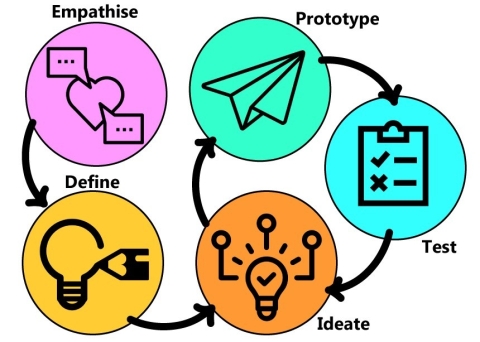
Main navigation - Library
Secondary Menu - Library
Secondary menu
Search suggestions update instantly to match the search query.
Thinking like a designer

A faculty-based learning developer (LD) must accommodate the full range of subjects and types of learners in their specific contexts. The ‘design thinking’ (DT) five basic stages of ‘empathise, define, ideate, prototype, test’ that I am about to look at more closely are often criticised as being too simple. But simplicity is often underrated and I suggest that we should accept them as a sound and well-established catalyst for learning development.
The design cycle
Creative students in most of the subjects offered by the faculty of CCI will come across ‘design thinking’ at an early stage in their studies. The ubiquity and foundational principles of design theory provide a useful common starting point for planning sessions for CCI students. Further, the structure and many of the characteristics of the model are shared with the principles of one-to-one academic skills session. An understanding of the process can equally help to investigate best ways of dealing with student issues in a session.
One significant difference between LD and DT is that the ‘customers’ from the original design text are ‘students’ in our settings – even though a lot of people nowadays argue that paying students are ‘customers’. As an LD I have to disagree since our work is based on student-centred principles in pedagogy.
Here is a closer look at design thinking = thinking of a designer/ creative student in five stages:
So often, a stressed out student presents themself with "This is what I have done so far and I cannot see the wood for the trees. Oh, and my deadline is tomorrow or the day after". Ouch! Especially the latter. How then do I calm someone down who is not prepared/able to take a step back because of the time pressure of an immediate deadline? Discussing the bigger picture is so important; it is always worth a try.
However ‘empathising’ is something entirely different again. This actually means, by definition, to step into someone’s shoes or at least speak the same language. It must be said, that the actual meaning of ‘empathy’ might be misplaced here. Bloom argues that actual empathy would make a doctor unfit to operate. He draws our attention to the ‘utilitarian principles where the effective allocation of resources trumps the warm glow of a more singular and intimate concern’. Hmm, this certainly offers food for further thoughts.
There is so much in here to take away. As a start, first impressions at the beginning of a session are so important. Helping students to take a step back, and breathe in, which actually calms them down and makes them realise their haste (well, most of them), is the anchor point to ‘engagement’. In a millisecond, the tutor must judge the situation and observe the stressed out behaviour the student presents. Moreover, well, we are not trained psychologists nor counsellors. I do, however, recognise the elements required for my job to deal with these ever so crucial opening situations.
Get them talking! What? How? Why? My favourite opener is to question their stance on where the student sees a piece of assessment in connection to the whole module, followed by the purpose of it (why do I need to do this?). I have always called it zooming out of the piece and then coming back to it. (Not many remember the title of the module.) Can the student clearly vocalise what the task entails? Every so often it is a rushed judgement by the student ‘I answer what I think is needed’. Considering the high percentage of learners with dyslexia in a creative environment (plus students with Aspergers, anxieties, etc), it is not surprising that many misinterpret a task at the first attempt.
Finally, it is ‘socio-cognitive relevance’ that drives a student to come out of an LD session and feel GOOD about it. How useful was it for me? + how meaningful? + perception at the time. Pragmatism is of essence here but also a link to self-efficacy as again linked back to the bigger picture:
Basic design thinking has its value for the development of learning especially in a creative faculty. Some people call it clichéd, some overused, but I trusted and investigated it in relation to my area of academic skills development. I drew out the original methodological ‘bones’ and applied them to a face-to-face session that students could benefit from as part of their own learning experience. Especially the ideation stage requires time for thinking and digesting ideas. Overall, it is a useful basic framework that helps anybody to generate creative ideas and is worth using as a template.
In a creative faculty, learning developers possess the tools to facilitate and coach students to see and use strong parallels between design and critical academic thinking.
References
Institute of Design at Stanford. (n.d.). An Introduction to Design Thinking. https://dschool-old.stanford.edu/sandbox/groups/designresources/wiki/36873/attachments/74b3d/ModeGuideBOOTCAMP2010L.pdf
Malamed, C. (2018, 16 March). A designer addresses criticism of design thinking. Learning Solutions. https://learningsolutionsmag.com/articles/a-designer-addresses-criticism-of-design-thinking
Kilian, J., Sarrazin, H., & Seitz, B. (2016, 1 March). The power of design thinking. McKinsey Digital. https://www.mckinsey.com/business-functions/mckinsey-digital/our-insights/the-power-of-design-thinking#
University of Portsmouth. (2019). Learning development toolkit: An introduction to design thinking. https://app.goodpractice.net/#/uni-portsmouth-tfl/s/ff5c4a06
Vickers, S. (2017, 6 February). Against empathy by Paul Bloom; the empathy instinct by Peter Bazalgette: Review. The Guardian. https://www.theguardian.com/books/2017/feb/06/against-empathy-paul-bloom-the-empathy-instinct-peter-bazalgette-review
Image credits
Images adapted from the following designers from the Noun Project:
'Empathise' by Sumi Saengthong
'Define' by Jim Slatton
'Ideate' by Adrien Coquet
'Prototype' by Maxim Kulikov
'Test' by Shaa

